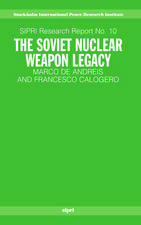Alliance Management and Maintenance: Restructuring NATO for the 21st Century
Autor John R. Denien Limba Engleză Hardback – 28 iun 2007
Preț: 1000.27 lei
Preț vechi: 1219.84 lei
-18% Nou
Puncte Express: 1500
Preț estimativ în valută:
191.39€ • 199.85$ • 158.05£
191.39€ • 199.85$ • 158.05£
Carte tipărită la comandă
Livrare economică 16-30 aprilie
Preluare comenzi: 021 569.72.76
Specificații
ISBN-13: 9780754670391
ISBN-10: 0754670392
Pagini: 286
Dimensiuni: 156 x 234 x 10 mm
Greutate: 0.45 kg
Ediția:1
Editura: Taylor & Francis
Colecția Routledge
Locul publicării:Oxford, United Kingdom
ISBN-10: 0754670392
Pagini: 286
Dimensiuni: 156 x 234 x 10 mm
Greutate: 0.45 kg
Ediția:1
Editura: Taylor & Francis
Colecția Routledge
Locul publicării:Oxford, United Kingdom
Recenzii
'This insightful book sheds new light on NATO’s dirty little secret: NATO is, has always been, and will continue to be a voluntary alliance of sovereign nation states. For this reason, political bargaining plays a critical role in shaping both missions and forces, particularly in an era when threats are so diverse, ambiguous and geographically dispersed.' Stanley R. Sloan, Middlebury College, USA 'John Deni provides a terrific account of NATO's evolution since the end of the Cold War. With his deep knowledge of military doctrine and his probing research on the political influences shaping NATO's force structure, Deni has made a valuable contribution to our study of alliances.' James Goldgeier, George Washington University, USA 'The book is meant as a bridge between scholarly studies on alliance formation and duration, and more practical studies on NATO transformation...The achievement of this book is that is offers the reader an original assessment of the management efforts made yesterday to explain the (not excellent) state of the organization today.' The International Spectator
Notă biografică
John R. Deni is Political Advisor for the European headquarters of the US Army in Heidelberg, Germany.
Cuprins
Chapter 1 Introduction; Chapter 2 Managing Alliances; Chapter 3 Assessing Military Doctrine and Structures; Chapter 4 The Development of the NRDCs; Chapter 5 Changing Threats and the Alliance’s Response; Chapter 6 The Impact of Political Bargaining; Chapter 7 The Alliance’s Response to Terrorism; Chapter 8 Conclusions and Implications;
Descriere
Providing new empirical data valuable to our understanding of NATO's post-Cold War evolution, this book offers a unique perspective on alliance management and maintenance. It sheds light on the continuing debate surrounding NATO's role in security, how the alliance will fight and whether NATO is properly structured to continue providing security for its member states.














